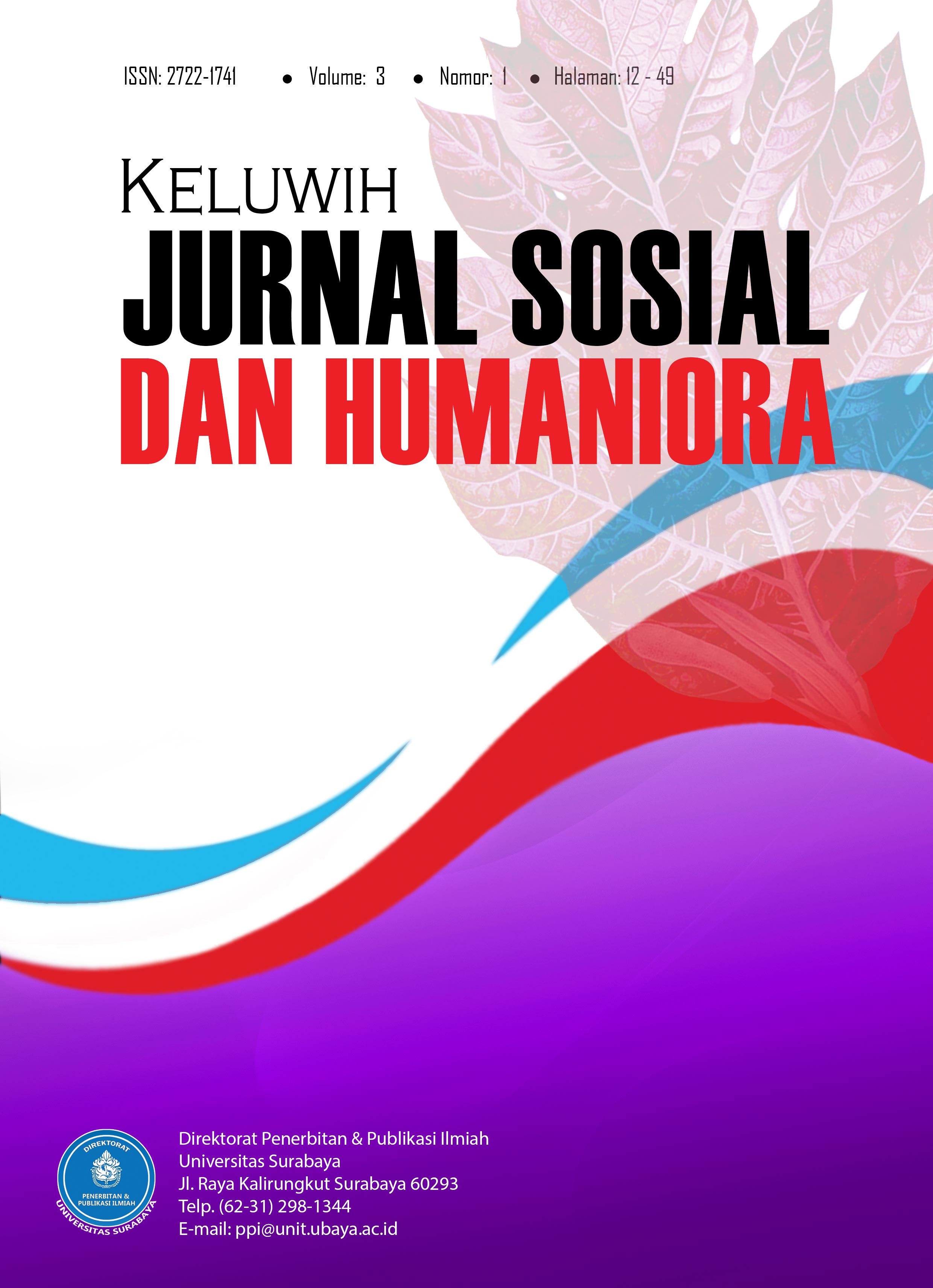Self Efficacy dan Burnout pada Guru
 Abstract Views:
1392 times
Abstract Views:
1392 times
 PDF Downloads:
1568 times
PDF Downloads:
1568 times
Abstract
Abstract—Teachers play an important role in student achievement and development so teachers are required to perform well in the learning process. In addition, teachers have a variety of tasks that are so heavy that these demands can cause teachers to be vulnerable to burnout. This study aims to find out if there is a relationship between self-efficacy and burnout in teachers. The research subjects (N=107) were teachers at two Bondowoso Vocational Schools with a minimum teaching period of 5 years. Data collection was done using Maslach Burnout Inventory (Maslach & Jackson, 1981) and Teacher Sense of Efficacy Scale (Tschannen-Moran & Woolfolk, 2001). The results of the analysis used spearman values that showed that there is a significant negative relationship (p<0.05) between self-efficacy and burnout with r = -0.398. All three aspects of self-efficacy have significant value but in teacher efficacy for classrom management aspects have the highest contribution with burnout (r = -0.406). Burnout levels in the two SMK have very low values and have a high level of self-efficacy. The level of self-efficacy is related to the low burnout rate in teachers at Bondowoso Vocational High School.
Keywords: burnout, teacher’s, self-efficacy
Abstrak—Guru memiliki peran penting dalam prestasi dan perkembangan siswa sehingga guru diharuskan untuk memiliki kinerja yang baik dalam proses pembelajaran. Selain itu guru memiliki berbagai tugas yang sangat berat sehingga tuntutan tersebut dapat menyebabkan guru rentan mengalami burnout. Penelitian ini bertujuan untuk mengetahui apakah terdapat hubungan antara self-efficacy dengan burnout pada guru. Subjek penelitian (N=107) adalah guru di dua SMK Bondowoso dengan minimal masa mengajar 5 tahun. Pengumpulan data dilakukan dengan menggunakan Maslach Burnout Inventory (Maslach & Jackson, 1981) dan Teacher Sense of Efficacy Scale (Tschannen-Moran & Woolfolk, 2001). Hasil analisis menggunakan nilai Spearman yang menunjukkan bahwa terdapat hubungan negatif yang signifikan (p<0.05) antara self-efficacy dan burnout dengan r = -0.398. Ketiga aspek self-efficacy memiliki nilai yang signifikan namun pada aspek teacher efficacy for classrom management memiliki kontribusi yang paling tinggi dengan burnout (r = -0.406). Tingkat burnout yang ada di dua SMK memiliki nilai yang sangat rendah dan memiliki tingkat self-efficacy yang tinggi. Tingkat self-efficacy memiliki keterikatan dengan rendahnya tingkat burnout pada guru di SMK Bondowosoara.
Kata kunci: burnout, guru, self-efficacy
Downloads
References
Alwisol. (2009). Psikologi Kepribadian. Malang : UMM PressBandura, A. (1986). The explanatory and predictive scope of self-efficacy theory. Journal of Clinical and Social Psychology, 4, 359-373.
Bandura, A. (1986).The social learning perspective: Mechanisms of aggression. In H. Toch (Ed.), Psychology of crime and criminal justice (pp. 198-236). Prospect Heights, IL: Waveland Press
Bandura, A. (1997). Theoretical Perspectives: the nature of human agency. In Self-efficacy: The exercise of control (p.3) http://search.ebscohost.com/login.aspx?direct=true&db=a9h&AN=9703260522&site=eh ost-live
Feist, Jess., & Feist, Gregory J. 2009. Theories of personality (7th Edition). New York: McGraw- Hill.
Gumbau, S. L., & Marisa, S. S. (2014). Loss and Gain Cycles? A Longitudinal Study about Burnout, Engagement, and Self-Efficacy. Journal Burnout Research, 1(1).
Ghufron, M.N & R Rіѕnawіta. 2012. Teorі-Teorі Pѕіkologі. Yogyakarta: Ar-Ruzz Medіa
Harnida, H. (2015). Hubungan Efikasi Diri Dan Dukungan Sosial Dengan Burnout Pada Perawat.
Persona:Jurnal Psikologi Indonesia, 4(1). https://doi.org/10.30996/persona.v4i1.487
Ii, B. A. B. (2010). Hubungan Self Efficacy..., Ika Rizky Agustin Yodyanti, Fakultas Ilmu Kesehatan UMP, 2018. 13–38.
Malach-Pines, A. (2005). The Burnout Measure, Short Version. International Journal of Stress Management, 12(1), 78–88. https://doi.org/10.1037/1072-5245.12.1.78
Maslach, C. (2003). Job Burnout: New Directions in Research and Intervention. Current Directions in Psychological Science, 12(5), 189–192
https://doi.org/10.1111/1467- 8721.01258
Maslach, C., & Jackson, S. E. (1981). The measurement of experienced burnout. Journal of Organizational Behavior, 2(2), 99–113 https://doi.org/10.1002/job.4030020205
Maslach, C., Schaufeli, W. B., & Leiter, M. P. (2001). Ob urnout. 397–422.
Psikologi, J., Pendidikan, F. I., & Semarang, U. N. (2015). Yang Dimediasi Oleh Stres Pada Guru Tk.
Puspitasari, D. A., & Handayani, M. M. (2014). Hubungan Tingkat Self-Efficacy Guru dengan Tingkat Burnout pada Guru Sekolah Inklusif di Surabaya. Jurnal Psikologi Pendidikan Dan Perkembangan, 3(1), 59–68. http://journal.unair.ac.id/filerPDF/jppp2a9996ff38full.pdf
Rahman, U. (2007). Pada guru. 216–227.
Ramadian, G. (2012, 17 September). Waspada, stres intai 64 persen bekerja di Indonesia. okezone [on-line). Diakses pada tanggal 10 Oktober 2020 dari Waspada, Stres Intai 64 Persen Pekerja di Indonesia : Okezone Lifestyle
Rosyid, H.F. 1996. Burnout: Penghambat Produktivitas yang Perlu Dicermati. Buletin Psikologi, IV (1): 19-24.
Savas, A. C. (2014). A Study on the Relationship between Teacher Self Efficacy and Burnout. European Journal of Educational Research, 3(4), 159–166. https://doi.org/10.12973/eu- jer.3.4.159
Schaufeli, W.B., Maslach, C., & Marek, T. (Eds.). (1993). Professional burnout: Recent developments in theory and research. Washington, DC: Taylor & Francis.
Schaufeli, W. B., Enzmann, D., & Girault, N. (1993). Measurement of burnout: A review. In W. B. Schaufeli, C. Maslach, & T. Marek (Eds.), Series in applied psychology: Social issues and questions. Professional burnout: Recent developments in theory and research (p. 199–215). Taylor & Francis.
Septianisa, S., & Caninsti, R. (2016). Hubungan Self Efficacy Dengan Burnout Pada Guru Di Sekolah Dasar Inklusi. Journal Psikogenesis, 4 (1) 126 https://doi.org/10.24854/jps.v4i1.523
Shoji, K., Cieslak, R., Smoktunowicz, E., Rogala, A., Benight, C. C., & Luszczynska, A. (2016). Associations between job burnout and self-efficacy: A meta-analysis. Anxiety, Stress and Coping, 29(4), 367–386. https://doi.org/10.1080/10615806.2015.1058369
Suwanto, I., & Fitriyadi, S. (2019). Burnout Guru BK di Kota Singkawang. Counsellia: Jurnal Bimbingan dan konseling, 9(2) 127
https://doi.org/10.25273/counsellia.v9i2.5186
Sugiyono, Prof., Dr. (2010). Statistika untuk penelitian. Bandung: Alfabeta
Teori, J. P. (2016). Regulasi Diri dengan Burnout pada Guru Sysditya Ekawanti, Olievia Prabandini Mulyana Program Studi Psikologi Universitas Negeri Surabaya. 6(2), 113–118.
Tschannen-Moran, M., & Hoy, A. W. (2001). Teacher efficacy: Capturing an elusive construct. Teaching and Teacher Education, 17(7), 783–805. https://doi.org/10.1016/S0742- 051X(01)00036-1
Tschannen-Moran, M., & Hoy, A. W. (2007). The differential antecedents of self-efficacy beliefs of novice and experienced teachers. Teaching and Teacher Education, 23(6), 944–956. https://doi.org/10.1016/j.tate.2006.05.003
Tschannen-Moran, M., Hoy, A. W., & Hoy, W. K. (1998). Teacher efficacy: Its meaning and measure. Review of Educational Research, 68(2), 202–248. https://doi.org/10.3102/00346543068002202
Weinberg, R., Gould, D., & Jackson, A. (2019). Expectations and Performance: An Empirical Test of Bandura’s Self-efficacy Theory. Journal of Sport Psychology, 1(4), 320–331. https://doi.org/10.1123/jsp.1.4.320
Zaman, P. A. (2019). Hubungan Antara Grit Dan Burnout Pada Pekerja. 105.

This work is licensed under a Creative Commons Attribution-ShareAlike 4.0 International License.
- Articles published in Keluwih: Jurnal Sosial dan Humaniora are licensed under a Creative Commons Attribution-ShareAlike 4.0 International license. You are free to copy, transform, or redistribute articles for any lawful purpose in any medium, provided you give appropriate credit to the original author(s) and the journal, link to the license, indicate if changes were made, and redistribute any derivative work under the same license
- Copyright on articles is retained by the respective author(s), without restrictions. A non-exclusive license is granted to Kluwih: Jurnal Sosial dan Humaniora to publish the article and identify itself as its original publisher, along with the commercial right to include the article in a hardcopy issue for sale to libraries and individuals.
- By publishing in Keluwih: JSH, authors grant any third party the right to use their article to the extent provided by the Creative Commons Attribution-ShareAlike 4.0 International license.

 DOI:
DOI:


 Digital Object Identifier
Digital Object Identifier Mendeley
Mendeley


